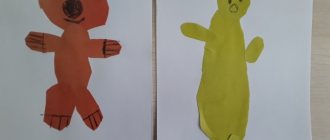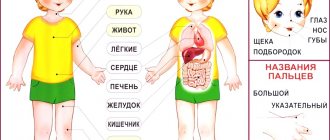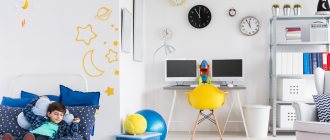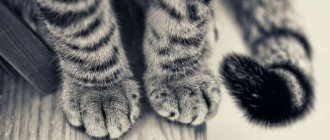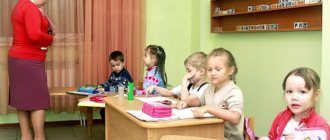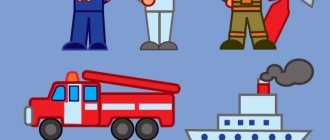- home
- Speech development
Preschoolers need to receive at least minimal information about anatomy and be able to name the parts of their body. This topic is included in the educational program for children from 3 to 5 years old. Pictures for children “Parts of the human body” help teachers of kindergartens and educational centers make such lessons not theoretical, but filled with examples, visualize new knowledge. We will tell you in our article how to structure a lesson with kindergarteners, what exercises and games help them memorize new material.
Game "Our Body"
To begin with, you only need to play it together. The host can be mom or dad. Start with the preparatory stage.
First stage. She simply touches a part of the child's body and says what it is called. Here tactile, auditory, and visual memory is immediately triggered. The baby feels a touch, hears a word, sees this area of the body.
If the baby is still a year old, then limit yourself to 2-3 items. It will be difficult for the baby to remember more and he may begin to get confused. The child will learn the name, construction of the question and how to answer.
Second phase. Start showing off body parts not only on your baby, but also on yourself. Introduce the concept of magnitude, difference.
To help, you can use songs or rhymes for little ones about body parts. Use them while reading and encourage your child to repeat after you.
“Hands clap-clap-clap (clap your hands),
With your feet, stomp-stomp-stomp (we pretend to walk in place, stomp),
Head so-so-so (we shake our heads from side to side),
Belly op-op-op (pat the belly).”
Such catchy rhymes and actions lift your spirits, and rhyme helps you remember names better. When the baby learns all the basic elements of the body, then you can start the game itself.
Rules of the game
We ask the child a question and ask him to show this part of the body on himself, and then on the presenter. The baby already remembers how the questions from the preparatory stage sound.
Praise your child if he guesses right. For children of this age, this is the best reward. He likes to hear kind words and see your pleasure from his answers. Remember, your positive emotions are transferred to the baby. If he hears approval from you, he won’t get tired of the game. He will happily return to her again. Praise motivates you to try to learn more.
Later you can add two more “players” to the game. Let these be different toys. It is best if you add a doll, a teddy bear, a horse or a dog, or a cat to the company. It is good if some animal stands upright on all fours. This will help the baby to clearly see the differences. Don't think that the doll is only suitable for girls. When studying the body, the human body is best shown. You can find a boy doll, Pinocchio or a soldier.
Now the task changes a little. Place all the toys in a row. Ask your baby to point out body parts. The child begins to understand that despite the fact that they are different, their body structure has something in common. Then invite him to reflect on the differences.
Also, you can ask to show what one toy has that the others don’t. For example, it could be a tail.
New stage. In addition to three-dimensional objects, you can use drawings. Ask what is where characters have in books, coloring books, and other drawings. The child develops an understanding of the body through pictures. You can draw simple pictures yourself according to the principle: “Hands, legs, cucumber - it turned out to be a little man”, “Dot, dot, comma - it turned out to be a crooked face.” The child will learn not only body parts on the torso, but also on the face.
Clippings. You can print and cut out images of body parts with scissors. The child's task is to put them in the right order. This is done in games for smartphones and other devices. If the picture is outline, then it can be colored.
Picture with a hint. The child can look at the clue and put it in the person.
Colored pictures attract attention. You can find a book with similar tasks
When to start studying body parts?
Anna Bykova “Developmental activities for the “lazy mother” “Through sensory experience, relying on vision and touch, he must find similarities and differences. “Mom also has a nose. But it's bigger than mine. And daddy's nose is bigger than mom's. And dad also has ears. If you pull dad's ears too hard, dad will scream that it hurts. And if you cover your ears with your hands, something will happen to your mother’s voice” - this is knowledge of the world, this is related to development, this is an invaluable experience, and, moreover, free.”
Ways to study body parts
- show body parts on yourself;
- show body parts on the baby;
- show body parts on a doll;
- show body parts on yourself with your own hands;
- use the baby’s hands to show parts of the body;
- touch the baby’s body parts with your hands;
- show body parts on other family members (dad, grandma, grandpa, brother, etc.)
Bend over so that your baby can see your face clearly. Smile. Don't show everything at once. At first, show only the nose, mouth, eyes, etc., so as not to overload the baby. Some babies show body parts by the age of one year, others show the results a little later. Don't rush the baby. Everyone has their own unique pace of development.
Progress of the lesson
A lesson in a preschool institution can be structured according to the following approximate plan:
| Lesson stage | What does it include | Duration | |
| 1. | Organizing time | We activate the children's attention to the beginning of the lesson. We greet you, seat you, create silence. | 1-2 minutes |
| 2. | Introductory part | We motivate interest in what is happening. You can ask a provocative question (Who knows how many body parts a person has? And others). Or tell an interesting story about a fairy-tale character who could not find and list all the parts of his body. Offer to help the character. | 3-4 minutes |
| 3. | Setting the task and goals of the lesson | We discuss with the children what we will do in class today, what new and interesting things we will learn (with children 3-4 years old), and create a problematic situation with children 5-6 years old. | 1-2 minutes |
| 4. | Games | Choose games aimed at memorizing the names of organs and their functions. Games can be carried out in the form of physical education. | 4 minutes |
| 5. | Warm-ups | Finger gymnastics. Performs two tasks: developing motor skills and learning the names of each finger | 3-4 minutes |
| 6. | Practical part | Let's look at the pictures. We find parts of our body from a friend, on a doll. We color, we draw. | 10 minutes |
| 7. | Reflection, summing up | We evaluate the lesson: liked it - didn’t like it. What new did you learn? Brief repetition of the main points (vocabulary). You can include riddles in reflection. | 2-3 minutes |
For children 2-3 years old, finger gymnastics replaces games and warm-ups. Can be used at the reflection stage. Learn memorable poems, show how to stretch your fingers and palms yourself.
This finger is grandpa, This finger is grandma, This finger is dad, This finger is mom, This finger is me, That’s my whole family!
Children bend their fingers on each hand separately and shake their fists intensively on the last lines.
Exercises
Use during the practical phase of the lesson. You will need pictures of “Body Parts” for children for clarity and example.
- Making up a person
Each child is given pictures of one part of the human body. The finished version is created in a group. Organize a competition for the elders to see who can assemble the person correctly the fastest.
- Where is the couple?
Mix up body parts for children in pictures. One pile should contain paired and unpaired parts. Task: to separate images based on pairing. Legs, ears, eyes, hands - in one, the rest - in the other.
- Call me kindly
I don’t have a hand, but a little hand, not a head, but a little head... It is advisable to combine lexical exercises with physical warm-up (stroking legs, arms, shaking your head, stretching your body to height). When naming a word, preschoolers look at pictures or photos for children “Parts of the human body.”
Important! Images cannot be printed in black and white. Pictures for viewing should be bright.
Games
Carry out game exercises in a group, actively. The main goal of the games: to provide new information in a memorable form. Positive emotions simplify the process of assimilation and consolidation.
- Why are they needed?
A game in the form of a question and answer. There are several answer options: detailed or yes - no. For children 3-4 years old, the following version of questions is suitable: Are ears needed to hear? YES! Do you need legs to eat? No! And so on.
For preschoolers in the middle group, ask a direct question: Why do they need legs, a head, etc. If possible, ask to justify the answer, give reasons.
- Robot
One child stands in the center of the group and completes several tasks from the children. For example, turn your head, wave your hand. The main thing is that when setting a task for a robot, preschoolers should use the names of body parts.
- Guess how much
The teacher shows a selection of photos on the topic “Sense organs pictures for children” and asks. How many ears, nostrils, tongues, eyes does a person have? Asks you to prove the correct answer by showing yourself.
Skeletal system
Digestive system
Respiratory system
Circulatory system
Puzzles
Lay out pictures or photos for children on the topic “Body Parts” on a large table. Gather the kids around him. Make riddles, the answer will be a raised card with a picture of the answer. Be sure to ask the respondent to name the correct organ and show it to yourself or a neighbor.
- No one sows them, no one plants them, they grow on their own! (Hair).
- In two holes the air wanders, then comes out, then comes in. (Nose).
- I’ll open my stable and show my friends the little white sheep. (Lips, mouth, teeth).
- If it weren't for him, no one would say anything. (Language).
- Ten brothers live in different houses. (Fingers).
- What do you need most at lunch? (Mouth).
- People have it. Animals have it. The person is smarter. (Head).
- Do you hear the water babbling? Wash your face more often... (Persons).
On a note! Riddles about parts of the human body can be presented in a presentation, followed by the correct answer in pictures for children.
What develops
The game “Our Body” develops:
- Ability to find similarities and differences;
- concept of sizes: more, less;
- ability to analyze;
- body image;
- attentiveness;
- memory.
Let's complicate it
There are several ways to make the game more difficult.
- Invite other children to join her. Place toys in front of them and give them a task. Explain that there is no need to answer in a race. You will have to be willing to listen to everyone. Limit yourself to 2-3 players. If there are more of them, then most likely the game will end in tears. After all, whoever does not have time to answer, someone will not have enough toys. The presenter will not be able to test everyone's knowledge.
- Introduce new characters into the game: birds, fish, lizards, insects, snakes. Their structure is slightly different from the usual idea of the body.
Rhymes about body parts
nursery rhymes and short sonorous poems
Here are the Pink Heels lying in the crib. Whose heels are these - soft and sweet? The goslings will come running and pinch your heels. Hide quickly, don’t yawn, cover with a blanket! We play with the doll. We perform imaginary actions: We wash our hands, feet, and wash our face.
My mouth can eat, my nose can breathe and my ears can listen, my little eyes can blink and blink, my hands can grab and grab everything.
I. Ilyina
These are the eyes to see. This is a nose for breathing. These are ears to hear. These are legs for running. These are arms to hug your mother very tightly.
Spider, spider, grab Anya by the side. Frog, frog, grab Anya by the ear. Deer, deer, grab Anya by the knees. Doggie, doggie, grab Anya by the nose. Hippopotamus, hippopotamus, grab Anya by the stomach. Wasp, wasp, grab Anya by the hair. Grasshoppers, grasshoppers, grab Anya by the shoulders.
Mirror
Repeat after me, raise/lower your pen. Repeat after me, and grab yourself by the nose/and press on your nose. Repeat after me, open your eyes wider/blink your eyes quickly. Repeat after me, pinch your ears/repeat after me, rub your ear. You repeat after me, open your mouth / repeat after me, little mouth, now speak (we chant vowel sounds).
